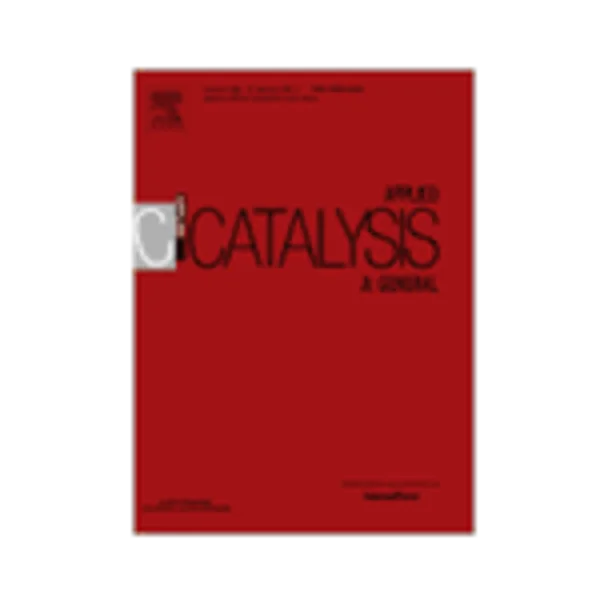-
citral hydrogenation on high surface area mesoporous tio2–sio2 supported pt nanocomposites: effect of titanium loading and reduction temperature on the catalytic performances
جزئیات بیشتر مقاله- تاریخ ارائه: 1392/07/24
- تاریخ انتشار در تی پی بین: 1392/07/24
- تعداد بازدید: 1025
- تعداد پرسش و پاسخ ها: 0
- شماره تماس دبیرخانه رویداد: -
platinum-based catalysts supported on tio2-modified mesostructured silica were prepared using the direct co-condensation of silica and titania precursors to synthesize the mixed-oxide support. the physico-chemical properties of the pt/xti-sba15 samples with various xti contents (in mol%) were further evaluated using several techniques, including elemental analysis, x-ray diffraction, n2-physisorption, h2-chemisorption, transmission electronic microscopy and the probe reaction of cyclohexane dehydrogenation to evaluate the metal–support interaction (smsi effect). all the pt/xti-sba15 samples display high specific surface areas (650–820 m2 g−1) and high mesopore volumes (0.44–0.68 cm3 g−1), with the formation of tio2anatase nanoparticles since the low titanium content, i.e. 2 mol%. the hexagonal organized pore structure of sba silica is also strongly altered by the titanium adding, but mixed oxides so obtained present very particular morphology with maintaining of high surface areas. the catalytic performances of the pt/xti-sba15 catalysts were estimated for the citral hydrogenation performed at 70 °c under hydrogen pressure (7 mpa), and discussed in terms of activity and unsaturated alcohols (ua: nerol and geraniol) selectivity. a synergetic effect on the ua selectivity was obtained on the pt/xti-sba15 catalysts, compared to both pt/sba15 and pt/tio2 p25 reference samples (reduction temperature = 300 °c), and was explained by the specific role of the reducible tio2 species, which under the nano-anatase form generate a strong metal–support interaction (smsi effect) with platinum after reduction at 300 °c. the formation of partially reduced support species was finally modulated by varying the reduction temperature of the catalysts. it is then possible to achieve high selectivity after reduction at 350 °c, while maintaining high conversions.
مقالات جدیدترین رویدادها
-
استفاده از تحلیل اهمیت-عملکرد در ارائه الگوی مدیریت خلاقیت سازمانی و ارائه راهکار جهت بهبود
-
بررسی تاثیر ارزش وجوه نقد مازاد بر ساختار سرمایه شرکت های پذیرفته شده در بورس اوراق بهادار تهران
-
بررسی تأثیر سطح افشای ریسک بر قرارداد بدهی شرکت های پذیرفته شده در بورس اوراق بهادار تهران
-
بررسی تأثیر رتبه بندی اعتباری مبتنی بر مدل امتیاز بازار نوظهور بر نقد شوندگی سهام با تأکید بر خصوصی سازی شرکت ها
-
تأثیر آمیخته بازاریابی پوشاک ایرانی بر تصویر ذهنی مشتری پوشاک ایرانی (هاکوپیان)
-
بررسی اثر ارتعاشات قطار زیر زمینی شهر قم بر بنای تاریخی سر درب مدرسه غیاثیه
-
فلسفه تکنولوژی بر مبنای صدرالمتالهین و از منظر هایدگر
-
بررسی حساسیت کژدم های خطرناک استان هرمزگان نسبت به حشره کش های شیمیایی پیشنهادی who
-
مروری بر آزمایش های مربوط به ستون های لوله فولادی بیضوی پر شده با بتن خود متراکم
-
enhancement of wear resistance of ductile iron surface alloyed by stellite 6
مقالات جدیدترین ژورنال ها
-
مدیریت و بررسی افسردگی دانش آموزان دختر مقطع متوسطه دوم در دروان کرونا در شهرستان دزفول
-
مدیریت و بررسی خرد سیاسی در اندیشه ی فردوسی در ادب ایران
-
واکاوی و مدیریت توصیفی قلمدان(جاکلیدی)ضریح در موزه آستان قدس رضوی
-
بررسی تاثیر خلاقیت، دانش و انگیزه کارکنان بر پیشنهادات نوآورانه کارکنان ( مورد مطالعه: هتل های 3 و 4 ستاره استان کرمان)
-
بررسی تاثیر کیفیت سیستم های اطلاعاتی بر تصمیم گیری موفق در شرکتهای تولیدی استان اصفهان (مورد مطالعه: مدیران شرکتهای تولیدی استان اصفهان)
-
کاربرد شناساگرهای زیستی در ارزیابی محیط زیست
-
اسکن فانتوم، گامی مهم در کالیبراسیون اولتراسوند سه بعدی و مقایسه روش های مختلف آن
-
بررسی رابطه بین افشای مسئولیت اجتماعی شرکت و سهم بازار
-
رفتارهای انحرافی در سازمان: تبیین نقش ادراک حمایت سازمانی و بی عدالتی، ناکامی و شخصیت
-
اثربخشی تصویرسازی ذهنی بر میزان نشخوار فکری و امید به زندگی نوجوانان افسرده شهرستان بابل




سوال خود را در مورد این مقاله مطرح نمایید :